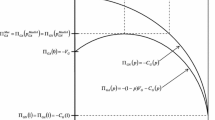Abstract
In this paper, we develop a model for the timing and deterrence of terrorist attacks due to exogenous dynamics. The defender moves first and the attacker second in a two-stage game which is repeated over T periods. We study the effects of dynamics of several critical components of counter-terrorism games, including the unit defence costs (eg, immediately after an attack, the defender would easily acquire defensive funding), unit attack costs (eg, the attacker may accumulate resources as time goes), and the asset valuation (eg, the asset valuation may change over time). We study deterministic dynamics and conduct simulations using random dynamics. We determine the timing of terrorist attacks and how these can be deterred.






Similar content being viewed by others
References
Amegashie JA (2006). A contest success function with a tractable noise parameter. Pub Choice 126: 135–144.
Bandyopadhyay S and Sandler T (2011). The interplay between preemptive and defensive counterterrorism measures: A two-stage game. Economica 78 (311): 546–564.
Barros CP, Passos J and Gil-Alana LA (2006). The timing of ETA terrorist attacks. J Pol Model 28 (3): 335–346.
Berman O and Gavious A (2007). Location of terror response facilities: A game between state and terrorist. Eur J Opl Res 177 (2): 1113–1133.
Berrebi C and Lakdawalla D (2007). How does terrorism risk vary across space and time? An analysis based on the Israeli experience. Defence Peace Econ 18 (2): 113–131.
Bier VM, Oliveros S and Samuelson L (2007). Choosing what to protect: Strategic defensive allocation against an unknown attacker. J Pub Econ Theory 9: 563–587.
Brown G, Carlyle M, Salmeron J and Wood K (2006). Defending critical infrastructure. Interfaces 36: 530–544.
Clauset A, Young M and Gleditsch KS (2007). On the frequency of severe terrorist events. J Conflict Resolut 51: 58–87.
Enders W and Sandler T (2003). What do we know about the substitution effect in transnational terrorism? In: Silke A and Ilardi G (eds). Research on Terrorism: Trends, Achievements and Failures. Frank Cass: London.
Enders W and Sandler T (2005). After 9/11: Is it all different now? J Conflict Resolut 49 (2): 259–277.
Feichtinger G and Novak A (2008). Terror and counterterror operations: Differential game with cyclical Nash solution. J Optim Theory Appl 139 (3): 541–556.
Hausken K (2008). Whether to attack a terrorist's resource stock today or tomorrow. Games Econ Behav 64 (2): 548–564.
Hausken K, Bier V and Zhuang J (2009). Defending against terrorism, natural disaster, and all hazards. In: Bier VM and Azaiez MN (eds). Game Theoretic Risk Analysis of Security Threats. Springer: New York, pp 65–97.
Hausken K and Zhuang J (2011a). Governments’ and terrorists’ defense and attack in a T-period game. Decis Anal 8 (1): 46–70.
Hausken K and Zhuang J (2011b). Defending against a terrorist who accumulates resources. Military Opns Res 16 (1): 21–39.
Keohane N and Zeckhauser RJ (2003). The ecology of terror defense. J Risk Uncertainty 26: 201–229.
Levitin G and Hausken K (2008). Protection vs. redundancy in homogeneous parallel systems. Reliab Eng Syst Saf 93 (10): 1444–1451.
Raczynski S (2004). Simulation of the dynamic interactions between terror and anti-terror organizational structures. J Artif Soc Social Simul 7 (2), http://jasss.soc.surrey.ac.uk/7/2/8.html.
Sandler T and Siqueira K (2009). Games and terrorism. Simulation & Gaming 40 (2): 164–192.
Skaperdas S (1996). Contest success functions. Econ Theory 7: 283–290.
Telesca L and Lovallo M (2006). Are global terrorist attacks time-correlated? Phys A—Statist Mech Appl 362 (2): 480–484.
Tullock G (1980). Efficient rent-seeking. In: Buchanan JM, Tollison RD and Tullock G (eds). Toward a Theory of the Rent-Seeking Society. Texas A&M University Press: College Station, pp 97–112.
Udwadia FE, Leitmann G and Lambertini L (2006). A dynamical model of terrorism. Disc Dynam Nature Soc. doi: 10.1155/DDNS/2006/85653, pp. 1–32.
Zhuang J and Bier VM (2007). Balancing terrorism and natural disasters—Defensive strategy with endogenous attack effort. Opns Res 55 (5): 976–991.
Zhuang J, Bier VM and Alagoz O (2010). Modeling secrecy and deception in a multiple-period attacker-defender signaling game. Eur J Opl Res 203 (2): 409–4180.
Acknowledgements
This research was partially supported by the United States Department of Homeland Security through the National Center for Risk and Economic Analysis of Terrorism Events (CREATE) under award number 2010-ST-061-RE0001. However, any opinions, findings, and conclusions or recommendations in this document are those of the authors and do not necessarily reflect views of the United States Department of Homeland Security, or CREATE. Author names were listed alphabetically by last name.
Author information
Authors and Affiliations
Corresponding authors
Rights and permissions
About this article
Cite this article
Hausken, K., Zhuang, J. The timing and deterrence of terrorist attacks due to exogenous dynamics. J Oper Res Soc 63, 726–735 (2012). https://doi.org/10.1057/jors.2011.79
Received:
Accepted:
Published:
Issue Date:
DOI: https://doi.org/10.1057/jors.2011.79




